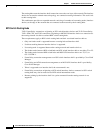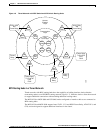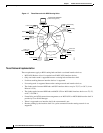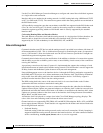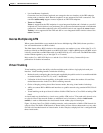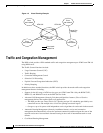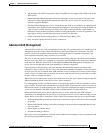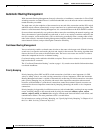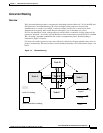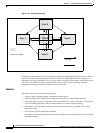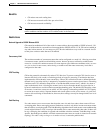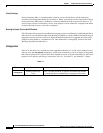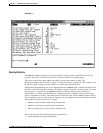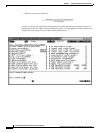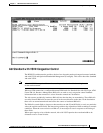
1-22
Cisco BPX 8600 Series Installation and Configuration
Release 9.3.10, Part Number 78-11603-01 Rev. D0, July 2001
Chapter 1 The BPX Switch: Functional Overview
Traffic and Congestion Management
Automatic Routing Management
With Automatic Routing Management (formerly referred to as AutoRoute), connections in Cisco WAN
switching networks are added if there is sufficient bandwidth across the network and are automatically
routed when they are added.
You need enter only the endpoints of the connection at one end of the connection and the IGX switch
and BPX switch software automatically set up a route based on a sophisticated routing algorithm. This
feature is called Automatic Routing Management. It is a standard feature on the IGX and BPX switches.
System software automatically sets up the most direct route after considering the network topology and
status, the amount of spare bandwidth on each trunk, as well as any routing restrictions entered by the
user (for example, avoid satellite links). This avoids having to manually enter a routing table at each
node in the network. Automatic Routing Management simplifies adding connections, speeds rerouting
around network failures, and provides higher connection reliability.
Cost-Based Routing Management
You can selectively enable cost-based route selection as the route selection per node. With this feature,
a trunk cost is assigned to each trunk (physical and virtual) in the network. The routing algorithm then
chooses the lowest-cost route to the destination node. The lowest cost routes are stored in a cache to
reduce the computation time for on-demand routing.
Cost-based routing can be enabled or disabled at anytime. There can be a mixture of cost-based and
hop-based nodes in a network.
The “Cost-Based Connection Routing” section on page 1-36, contains more detailed information about
cost-based AutoRoute.
Priority Bumping
Priority bumping allows BPX and IGX switch connections classified as more important (via COS
value) to “bump” (that is, set aside) existing connections of lesser importance. While the Automatic
Routing Management feature is capable of automatically redirecting all failed connections onto other
paths, priority bumping lets you prioritize and sustain more important connections when network
resources are diminished to a point that all connections cannot be sustained. Network resources are
reclaimed for the more important connections by bumping (derouting) the traffic on less important
connections.
Priority bumping is triggered by insufficient resources (such as bandwidth), resulting from any number
events, including changes to the network made by using the commands addcon, upcon, cnfcon,
cnnfcos, cnfpref, cnftrk,anddeltrk. Other triggers include trunk line/card failure, node failure, and
communication failure. The most prominent event is a trunk failure.
For information on setting up Priority Bumping, see “Specifying Priority Bumping” in Chapter 10 of
the Cisco WAN Switching Command Reference.



